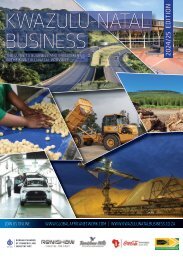Gauteng Business 2016 edition
The 2016 edition of the Gauteng Business and Investment Guide is the premier business and investment guide for the Gauteng province and the Gauteng Growth and Development Agency (GGDA). In addition to detailed profiles of key provincial organisations, including the GGDA, the Automotive Industry Development Corporation Centre (AIDC), the Gauteng Investment Centre, the Gauteng IDZ, the Gauteng ICT Park SEZ and Constitution Hill, this edition includes well-researched economic and demographic data on the province, as well as insights into the province’s five development corridors and the new industries and development nodes in these corridors; a focus on Gauteng as a global city region; and key growth sectors for the province.
The 2016 edition of the Gauteng Business and Investment Guide is the premier business and investment guide for the Gauteng province and the Gauteng Growth and Development Agency (GGDA). In addition to detailed profiles of key provincial organisations, including the GGDA, the Automotive Industry Development Corporation Centre (AIDC), the Gauteng Investment Centre, the Gauteng IDZ, the Gauteng ICT Park SEZ and Constitution Hill, this edition includes well-researched economic and demographic data on the province, as well as insights into the province’s five development corridors and the new industries and development nodes in these corridors; a focus on Gauteng as a global city region; and key growth sectors for the province.
You also want an ePaper? Increase the reach of your titles
YUMPU automatically turns print PDFs into web optimized ePapers that Google loves.
Incentives<br />
SPECIAL FEATURE<br />
As with any growing economy, business incentives are a vital component to getting new<br />
projects off the ground, especially during tough economic times. Discover which sectors<br />
are most suitable when perusing incentives in <strong>Gauteng</strong>, a province that prides itself on<br />
facilitating development.<br />
It must be noted firstly that the South African Government is giving<br />
consideration to expanding incentives for labour-intensive projects<br />
undertaken within IDZs to stimulate job creation, making that a<br />
prime area of investment.<br />
Urban Development Allowances<br />
For the construction of buildings, investors and firms can benefit from<br />
deductible allowances of up to 20 percent of the costs incurred in<br />
the development of new buildings or the refurbishment of existing<br />
buildings in designated urban development zones.<br />
Infrastructure Development<br />
In the case of infrastructure investments, a tax deduction of assets<br />
owned for the erection of pipelines, transmission lines and railway lines<br />
is available to encourage investment in local infrastructure.<br />
Public Private Partnerships<br />
Tax exemptions are provided for qualifying government grants that are<br />
utilised for the improvement of state-owned property. The objective<br />
of these exemptions is to encourage the private sector to invest in<br />
infrastructure in partnership with the public sector.<br />
Tax Incentives<br />
Preferential Corporate Tax Rate for Small <strong>Business</strong> Corporations Small<br />
and medium enterprises (SMEs) whose gross annual income does<br />
not exceed R14-million, are eligible for income tax deductions. The<br />
tax rates applicable to qualifying enterprises vary depending on their<br />
level of income.<br />
Research and<br />
Development<br />
Tax deductions of up to 150 percent<br />
are available for operational<br />
expenditure incurred during the<br />
discovery of new information, as<br />
well as in developing, designing<br />
and inventing programmes of a<br />
scientific or technological nature.<br />
Depreciation Allowances<br />
In the case of commercial buildings,<br />
a depreciation of 5 percent<br />
per annum is allowed on new or<br />
unused buildings, as well as for<br />
improvements used in the production<br />
of income. To qualify for<br />
the depreciation allowance, the<br />
building must be owned by a<br />
taxpayer.<br />
Rolling Stock Depreciation<br />
Tax deductions of 20 percent per<br />
annum are available for costs incurred<br />
in respect of rolling stock<br />
(trains, carriages and similar transportation<br />
modes) brought into<br />
use on or after 1 January 2008.<br />
The principal objective of allowable<br />
deductions on expenditure<br />
on rolling stock is to encourage<br />
43 GAUTENG BUSINESS <strong>2016</strong>


















